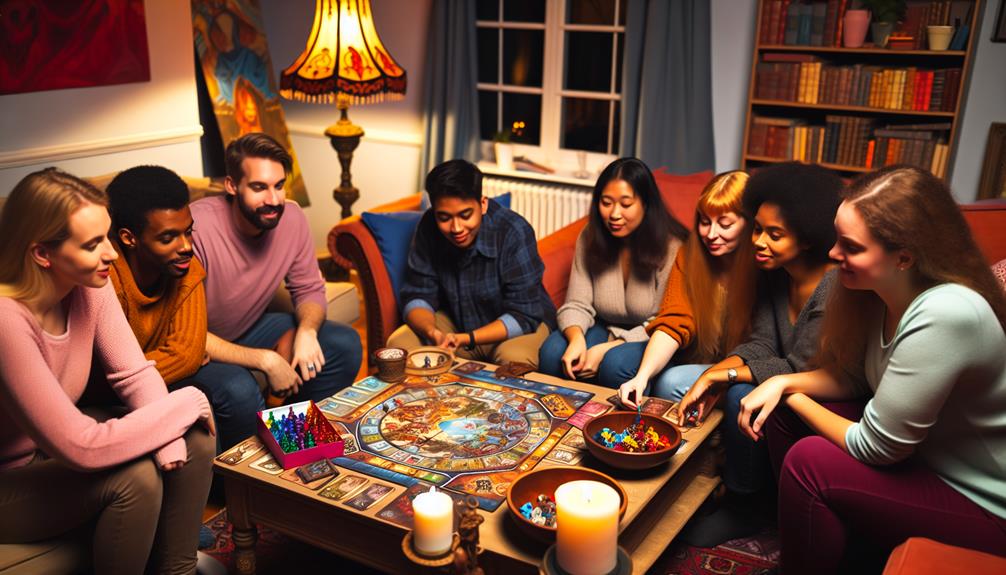Single-player games can provide compelling narratives and immersive worlds that resonate even more when enjoyed alongside friends. Cooperative storytelling in titles like "Life is Strange" or "God of War" enhances emotional connections through shared decision-making. Competitive high score challenges in games encourage healthy rivalries, fostering interactions that motivate achievement. Additionally, exploring vast open worlds, such as in "Red Dead Redemption 2," allows for shared discoveries and collaborative goal-setting. These experiences not only strengthen friendships but also enrich the gameplay itself. For an in-depth look at more titles and their unique features, further insights await.
Key Takeaways
- Single-player games with rich narratives, like Life is Strange, foster discussions among friends, enhancing the emotional experience together.
- Exploring vast open worlds in games like Red Dead Redemption 2 allows friends to share discoveries and strategize during gameplay.
- Cooperative challenges in single-player titles can be tackled by discussing strategies, promoting teamwork and strengthening friendships.
- Players can engage in friendly rivalries through competitive high score challenges in narrative-driven games, motivating shared achievement hunting.
- Immersive storytelling in single-player games creates memorable moments that friends can reminisce about, deepening their connection through shared experiences.
Co-op Storytelling Adventures

Co-op storytelling adventures offer a unique blend of narrative depth and collaborative gameplay, allowing players to immerse themselves in rich, interactive worlds while forging connections with friends. These experiences often feature intricate character development arcs, where players can witness their avatars grow and evolve in response to shared choices. This dynamic mirrors the journey of togetherness seen in real-life relationships, as players navigate challenges and make decisions that impact their collective experience. Engaging in such adventures can deepen emotional connections, much like the shared experiences of a couple's life, enhancing the overall enjoyment of the narrative. As friends engage in decision-making and face challenges together, they create memorable moments that resonate beyond the screen. The shared journey encourages a sense of belonging, as each participant contributes to a collective story, making co-op storytelling adventures a compelling way to bond and explore new narratives together.
Competitive High Score Challenges
While cooperative storytelling fosters emotional connections through shared narratives, competitive high score challenges offer a different kind of camaraderie among friends. These challenges ignite friendly rivalries, motivating players to engage in achievement hunting and showcase their skills. Score tracking becomes pivotal as participants climb the leaderboard, vying for bragging rights. It's crucial to assess the value of these challenges to determine if the excitement surrounding them is justified, particularly in the context of assessing trending gaming experiences.
Consider these engaging challenge variations:
- Time Trials: Compete against each other for the fastest completion times.
- Score Milestones: Set specific score targets that everyone must aim to surpass.
- Game-Specific Strategies: Share and develop unique tactics tailored to individual games.
- Weekly Challenges: Introduce a rotating game for a fresh competitive experience.
Ultimately, these challenges not only enhance enjoyment but also strengthen bonds through shared competition.
Puzzle Solving Together

Puzzle solving in single-player games offers a unique opportunity for friends to engage in cooperative gameplay mechanics that enhance the experience. These games often require critical thinking and creativity, making them perfect for discovering rewarding career paths that involve problem-solving skills. By developing shared strategies and fostering open communication, players can collaboratively tackle intricate challenges that would be intimidating alone. This collaborative approach not only strengthens friendships but also enriches the gaming experience through teamwork and mutual problem-solving.
Cooperative Gameplay Mechanics
Many gamers find that working together to solve intricate puzzles enhances the overall experience of single-player titles. Cooperative gameplay mechanics foster social interaction, allowing friends to engage in asynchronous gameplay while tackling challenges collectively. This collaborative approach not only deepens friendships but also enriches problem-solving skills. Here are four notable mechanics that elevate puzzle-solving experiences:
- Shared Information: Players exchange clues to reveal new areas or solutions.
- Role Assignments: Different players take on specific roles, leveraging individual strengths.
- Time Trials: Completing puzzles under time constraints encourages teamwork and quick thinking.
- Environmental Manipulation: Friends coordinate actions in-game, affecting the environment to solve puzzles.
Through these mechanics, players can cultivate a sense of belonging while enjoying the immersive narrative of single-player games.
Shared Strategy Development
The dynamics of puzzle-solving in single-player games can be considerably enhanced through shared strategy development among friends. Engaging in strategy brainstorming sessions allows players to combine their unique perspectives and experiences, fostering a sense of belonging and collaboration. As friends discuss intricate puzzles, they can devise multiplayer tactics that may not have been apparent when playing alone. This collective approach not only enriches the gaming experience but also strengthens social bonds, as participants feel valued for their contributions. The synergy created through shared insights can lead to innovative solutions, transforming the way puzzles are approached. Ultimately, embracing shared strategy development elevates the enjoyment of single-player titles, making the journey towards problem-solving a collective adventure.
Communication and Collaboration
Engaging with friends while tackling complex challenges in single-player games fosters an environment where communication and collaboration flourish. These virtual gatherings provide a unique opportunity to strengthen bonds through shared experiences. Players can enhance their problem-solving skills while maneuvering through intricate puzzles, ultimately leading to a rewarding collective achievement. Here are some ways to enhance communication and collaboration during gameplay:
- Discuss Strategies: Share insights and brainstorm solutions to overcome obstacles.
- Divide and Conquer: Assign specific tasks to maximize efficiency in puzzle-solving.
- Utilize Gaming Platforms: Leverage voice chat and screen sharing for real-time collaboration.
- Celebrate Milestones: Acknowledge successes together, reinforcing team spirit and camaraderie.
These strategies not only enhance the gaming experience but also deepen friendships.
Exploring Open Worlds
Open-world games offer a unique canvas for exploration, inviting players to traverse vast landscapes filled with intricate narratives and hidden treasures. Incorporating elements that encourage cooperative gameplay can enhance the experience, much like how educators weigh the benefits of tools like Study Island in classrooms to foster collaboration among students the pros and cons of educational tools. Engaging in open world exploration fosters a sense of camaraderie as friends can share the thrill of discovering secrets together. By discussing findings, strategizing routes, or simply marveling at the stunning environments, players enhance their experience. The joy of uncovering hidden gems or completing challenges becomes a shared adventure, deepening bonds and creating lasting memories. Additionally, the freedom to roam and interact with diverse elements allows for a personalized journey, making each player's experience distinct yet interconnected. Ultimately, these games cultivate a sense of belonging, where the shared pursuit of exploration and discovery unites friends in meaningful ways.
Engaging Narrative Experiences

Countless players are drawn to single-player games for their rich narratives and immersive storytelling, often finding themselves deeply invested in character development and plot progression. These narrative experiences create a shared space for friends to engage, discuss, and bond over compelling stories, especially when they are aware of essential insights for savvy investors that can enhance their overall gaming experience. Here are four significant single-player games that excel in storytelling:
- The Last of Us Part II – A gripping tale of love and revenge, showcasing profound character arcs.
- Life is Strange – An emotional journey that explores friendship and choices, inviting discussions about morality.
- Red Dead Redemption 2 – A sprawling narrative that explores loyalty and redemption within a vivid world.
- God of War – A father-son odyssey that intertwines myth and personal growth, fostering deep conversations.
These titles exemplify how immersive storytelling and character development can resonate with groups, creating lasting memories.
Creative Sandbox Games
Creative sandbox games offer a unique platform for players to build together and share their creations, fostering a sense of community and collaboration. These games often feature expansive worlds that invite exploration, each filled with distinctive elements waiting to be discovered. Additionally, engaging in collaborative challenges and goals enhances the multiplayer experience, allowing friends to unite their creativity in pursuit of shared objectives.
Building Together and Sharing
Engaging in collaborative building within sandbox games fosters a unique social experience, allowing players to express their creativity while working together toward shared goals. This interactive environment not only enhances gameplay but also facilitates the formation of lasting bonds. By collaborating on projects, players can enjoy the process of creating while building friendships and sharing experiences.
Key aspects of collaborative building include:
- Shared Vision: Aligning ideas to create cohesive structures.
- Resource Management: Strategizing together to optimize available materials.
- Problem Solving: Overcoming challenges as a united team.
- Creative Freedom: Encouraging individual expression within a collective framework.
These elements contribute to an enriching multiplayer environment, where creativity and camaraderie thrive.
Exploring Unique Game Worlds
What makes exploring unique game worlds in creative sandbox games such a fascinating experience? These games offer players the chance to investigate immersive environments that are rich in detail and creativity. The freedom to interact with the world around you fosters a sense of belonging, as players can express themselves through building, crafting, and exploring. Additionally, visual storytelling plays an essential role in these experiences; each world is a canvas that communicates narratives through landscapes, architecture, and design. Players can uncover hidden tales as they traverse these intricately designed spaces, forming connections with both the game and their friends. Ultimately, these unique worlds not only entertain but also invite players to share in the joy of discovery and creativity together.
Collaborative Challenges and Goals
The intricate environments found in creative sandbox games not only provide players with opportunities for exploration and expression but also serve as a foundation for collaborative challenges and goals. Engaging in these games fosters a sense of community as players unite to tackle obstacles that require team-based tactics and joint problem solving.
Here are four ways to enhance your collaborative experience:
- Build Together: Create elaborate structures or environments as a team, combining individual creativity.
- Cooperative Quests: Design and undertake missions that necessitate teamwork and strategic planning.
- Resource Management: Work collectively to gather materials, ensuring everyone contributes to the shared objective.
- Challenge Events: Set up competitions within the game, inviting friends to participate in friendly rivalry.
These collaborative efforts deepen connections and amplify enjoyment.
Nostalgic Retro Classics

Nostalgia often serves as a powerful catalyst for connection, drawing friends together to relive the cherished moments of their gaming past. Retro classics, with their pixelated memories, evoke a sense of belonging that transcends time. Titles like "The Legend of Zelda" and "Super Mario Bros." not only provide engaging single-player experiences but also invite companions to share in the joy of exploration and achievement. As retro remakes breathe new life into these beloved games, they allow for collective enjoyment, sparking conversations about strategies and shared triumphs. Whether gathering around a console or screen-sharing the experience, these nostalgic adventures foster camaraderie, reminding us that gaming is not just about competition but also about the connections we build along the way.
Frequently Asked Questions
Can I Play These Games Online With Friends?
The ability to play games online with friends often hinges on the presence of co-op features or dedicated multiplayer modes. Many titles offer these options, allowing players to collaborate or compete in a shared virtual space. Engaging in such experiences not only enhances gameplay but also fosters a sense of community and belonging among participants. It's crucial to explore each game's specifications to determine if it aligns with your social gaming preferences.
Are There Any Mobile Versions Available for These Games?
Many popular titles offer mobile versions, enhancing accessibility and convenience for players. When exploring game recommendations, it is essential to take into account mobile features that maintain the essence of the original experience. Notable games often include touch controls, optimized graphics, and social features that allow for interaction with friends. This adaptability fosters a sense of belonging among players, as they can engage with their favorite titles anytime and anywhere, regardless of platform limitations.
How Do I Share Progress With Friends in Single-Player Games?
Sharing progress in single-player games enhances engagement and fosters shared experiences among friends. Many contemporary games incorporate progress tracking features, allowing players to compare achievements and milestones. Social media integration, cloud saves, and in-game leaderboards facilitate this interaction, enabling players to celebrate each other's successes. By discussing strategies, sharing tips, and showcasing accomplishments, friends can cultivate a sense of belonging within the gaming community, enriching their overall gaming experience.
What Platforms Are These Games Available On?
The availability of games across various platforms is essential for enhancing user experience and fostering community engagement. Many modern titles boast platform compatibility, allowing players to enjoy the same game across different devices, such as consoles, PCs, and mobile platforms. In addition, cross-platform play facilitates interaction among friends, regardless of their chosen gaming device. This inclusivity not only broadens the player base but also enriches the gaming experience, promoting camaraderie and shared enjoyment.
Are There Any Age Restrictions for These Games?
Age restrictions for video games are primarily governed by game ratings, which provide essential insights into content appropriateness. Organizations such as the Entertainment Software Rating Board (ESRB) categorize games based on their themes, violence, language, and overall suitability for different age groups. Understanding these ratings enables players to make informed decisions, ensuring a safe and enjoyable experience. Additionally, awareness of these restrictions fosters a sense of belonging within a community that values responsible gaming.

